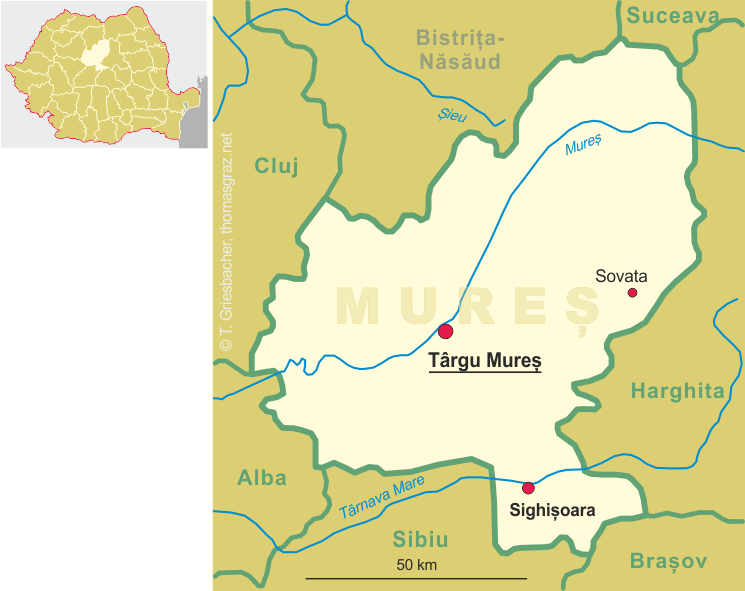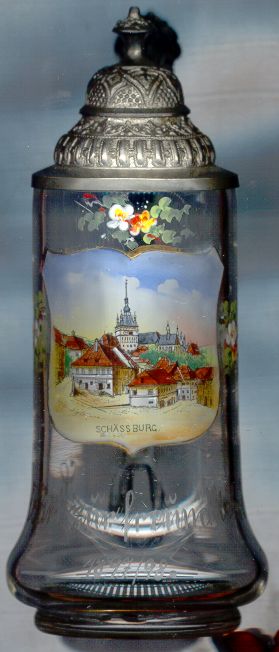
| ROMÂNIA | ROMANIA |
| județ Mureș | Mureș County |
 Sighișoara is situated at an elevation of 350–429 m at the Târnava Mare (Große Kokel) in the
Mureș county (capital Târgu Mureș) of the Transilvania region of central Romania.
It has a population (2004) of about 32,000.
Sighișoara is situated at an elevation of 350–429 m at the Târnava Mare (Große Kokel) in the
Mureș county (capital Târgu Mureș) of the Transilvania region of central Romania.
It has a population (2004) of about 32,000.
Archaeological finds show that the area of the city was populated by Scytians as of the 6th century BC. A Dacian fortress which was built in the 3rd century BC was called Sandava. The Romans built a fort here around 106. The town itself was founded presumably around 1200 by German settlers who had been called into the country by the Hungarian rulers. The town was first mentioned in a document of 1280 (castrum Sex); the name Schaespurch appears first in 1298, the name Seguzwar in 1377. Sighișoara (Schäßburg) was one of the so-called "Seven German towns of Transilvania" – together with Mühlbach (Sebeș, Szászsebes), Großschenk (Cincu, Nagysink), Reußmarkt (Miercurea Sibiului, Szerdahely), Reps (Rupea, Kőhalom), Leschkirch (Nocrich, Újegyház) and Broos (Orăștie, Szászváros) plus the main town, Hermannstadt (Sibiu, Nagyszeben) – that were granted the right to appoint there own leaders, their own clergy and judges, and operate markets and courts. The original fortress was destroyed by Tartars in 1241 and was replaced by new constructions which until the 14th century expanded into a citadel including more than 160 houses. The town's fortifications included 14 towers, which were maintained by the prospering guilds. Nine of these towers are still extant today. By 1367 Sighișoara had obtained the formal status of a town (civitas). In the 15th century, between 1431 and 1436, Vlad Dracul resided here. His son Vlad Țepeș (1431–1476; also called "Dracula", little Dragon), infamous for his cruelty (Țepeș means "the Impaler") and model for Bram Stoker's book Dracula (published 1897), was born in Sighișoara. During that period the Romanian name of the town appears in the documents for the first time. The Protestant Reformation, which affected all of Europe, had a profound impact on the Saxons of Transilvania. All of them converted to the Lutheran faith. In 1676 a large fired destroyed large parts of the town. Some parts of the fortifications and the citadel were destroyed during siege by the Kuruz rebels in 1704 and 1706. During the course of the 20th century Sighișoara became an important industrial center, with factories producing silk, wool and cotton cloth, clothing, ceramics, bricks and machine parts. The medieval citadel, however, fortunately remained untouched by this modern development. Most of the "Saxon" (i.e. German-speaking) population of Transilvania has left during the 20th century. Today the ethnic mix of Sighișoara includes Romanians, many Hungarians, less than 500 Saxons, and many Roma. The old town of Sighișoara was listed as a World Cultural Heritage by the UNESCO in 1999 (see also list of other UNESCO heritage sites).
Certainly the best-known landmark of Sighișoara is the  Clock Tower
Clock Tower
![[scale]](lineal.jpg)